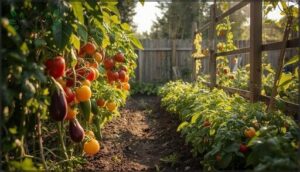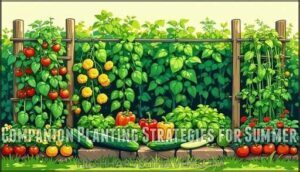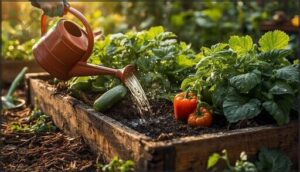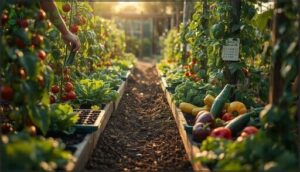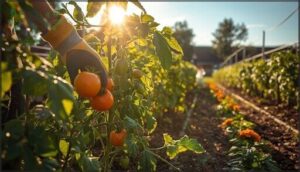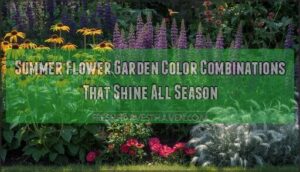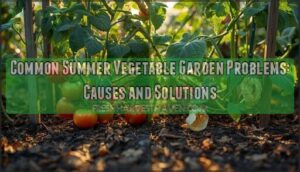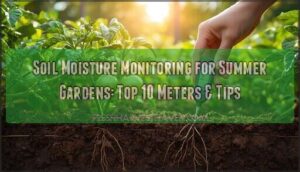This site is supported by our readers. We may earn a commission, at no cost to you, if you purchase through links.
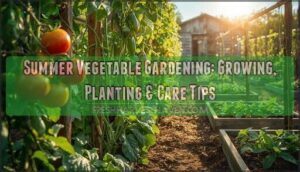 When the days stretch long and the soil warms beneath your feet, gardens come alive with surprising energy. Tomatoes swell with promise, beans climb skyward overnight, and even a single pepper plant can turn a backyard patch into a daily harvest.
When the days stretch long and the soil warms beneath your feet, gardens come alive with surprising energy. Tomatoes swell with promise, beans climb skyward overnight, and even a single pepper plant can turn a backyard patch into a daily harvest.
The rhythm of summer vegetable gardening isn’t about chasing trends—it’s about tuning in to what your soil and sun can give, season after season.
If you’re searching for practical ideas that make the most of heat, space, and time, you’ll find plenty here to help you nurture vibrant crops and savor the best flavors of summer.
Table Of Contents
- Key Takeaways
- Best Summer Vegetables to Grow
- Companion Planting Strategies for Summer
- Essential Soil and Watering Techniques
- Planting, Harvesting, and Succession Tips
- Managing Heat, Pests, and Garden Health
- Frequently Asked Questions (FAQs)
- What is the best vegetable to plant in summer?
- What is the 3-hour gardening rule?
- What vegetables can you grow in summer?
- How to grow summer vegetables in your backyard?
- What vegetables do kids like in a vegetable garden?
- What is the best vegetable garden layout?
- How do you grow a vegetable garden?
- When is the best time to plan a vegetable garden?
- What’s the best vegetable to grow in the summer?
- What is a good layout for a vegetable garden?
- Conclusion
Key Takeaways
- Choose heat-loving vegetables like tomatoes, peppers, cucumbers, and squash, and match their varieties to your climate for the best summer yields.
- Companion planting and crop rotation help prevent pests, improve soil health, and make the most of limited space in your garden.
- Deep watering, organic mulching, and timely fertilizing are key techniques to keep plants healthy and productive during hot weather.
- Stagger your planting and harvests through succession planting for a steady supply of fresh vegetables all summer long.
Best Summer Vegetables to Grow
Summer brings ideal conditions for growing a wide range of heat-loving vegetables. From classic tomatoes to crisp cucumbers, you’ll find options that thrive in long, sunny days and warm soil.
Here are the best summer vegetables to plant in your garden.
Tomatoes and Peppers
Tomatoes and peppers are summer vegetable gardening favorites, thriving when you match variety to your climate. Heat-tolerant tomato varieties like ‘Solar Fire’ and ‘Arkansas Traveler’ set fruit reliably above 90°F, while ‘Sun Gold’ can produce hundreds of fruits per season. Bell peppers such as ‘California Wonder’ yield up to nine fruits per plant with regular harvesting, and hot peppers like ‘Jalapeño M’ maintain productivity in temperatures exceeding 85°F.
Plant tomatoes with basil and marigolds for companion planting benefits that deter common pests.
Summer squash is another great option, as it’s known for being easy to grow.
Cucumbers and Melons
If you enjoy crisp, invigorating flavor in the heat, cucumbers and melons are summer garden standouts. Give cucumbers a trellis support for healthy growth and easier harvesting. Pick regularly to keep new fruit coming and avoid bitterness. Melons need consistent watering and careful timing for melon maturity. For adventurous growers, try dry farming to boost sweetness. These crops need full sun to thrive.
- Fresh cucumber crunch on a sweltering day
- Sun-warmed melons, sliced for family snacks
- Joy of finding a perfect fruit hidden under leaves
- Satisfying the thirst of late-summer afternoons
Eggplant and Okra
Once you’ve filled your basket with cucumbers and melons, focus on heat-tolerant vegetables like eggplant and okra. Both thrive during summer’s hottest spells, thanks to strong heat-wave tolerance.
Give them plenty of sun, enrich the soil, and watch for a swift maturation period. Harvest okra pods young—2 to 4 inches—so they stay tender and easy to cook.
Summer Squash and Beans
After you’ve planted your heat-tolerant vegetables, it’s time to think about summer squash and beans. Zucchini and other squash varieties thrive when the soil temperature hits 70°F. For beans, bush types offer quick returns, while pole beans—twisting up trellis structures—provide ongoing harvests.
Mixing these summer vegetables keeps fresh meals coming, weaving practicality and abundance into your vegetable gardening plan.
Heat-Tolerant Leafy Greens
When summer heat lingers, shifting toward heat-tolerant greens like Malabar spinach and Jericho lettuce pays off. These summer vegetables resist bolting, bringing fresh summer greens to your table all season.
Mulching benefits these heat-tolerant vegetables, keeping soil cooler and moisture steady.
Planting tropical spinach varieties guarantees a continual supply of greens, making your summer garden productive and resilient.
Companion Planting Strategies for Summer
Pairing certain vegetables together can make your garden healthier and more productive. Companion planting helps you keep pests in check and get the most out of your space.
Here’s what you need to know about choosing the best plant partners this summer.
Beneficial Plant Pairings
Have you ever noticed how some vegetables seem to thrive when they’re right beside the right neighbor in the garden? That’s the heart of companion planting. Tomatoes love basil for flavor enhancement, while corn aids climbing beans for space optimization.
These clever pairings provide nutrient synergy and growth support, making your summer garden more productive. This turns vegetable gardening into a smart partnership.
Pest Control With Companion Plants
With companion planting, you can repel with scents—like marigolds and basil—or use trap cropping to lure pests away from summer vegetables.
Habitat creation for beneficial insects boosts biological control, reducing the need for chemicals.
Companion plants make pest management natural and efficient, weaving in pest control as part of a healthy garden ecosystem right outside your back door.
Maximizing Space and Yield
Want to get more vegetables from every inch of your garden? Pair vertical gardening with intensive planting to make the most of small spaces. Intercropping benefits crops by combining different root zones, while succession strategies—such as successive planting—keep beds productive.
Companion planting and rotating crops help boost yields, even in container gardening. Every row and pot becomes a powerhouse.
Essential Soil and Watering Techniques
Getting your soil and watering right sets the stage for everything else in your summer garden. Each step below will help you build a strong, healthy foundation for your plants.
Let’s look at the most important techniques to keep your garden thriving.
Soil Preparation and Enrichment
Strong roots start with healthy soil. Before planting, use soil testing to check pH levels and nutrient balance—think of it as a garden check-up.
Composting methods, organic amendments, and rotating crops all improve soil health. Focus on rich, well-drained soil; proper soil preparation techniques and timely fertilizing and soil enrichment set your veggies up for a season of steady growth.
Watering Methods for Hot Weather
When the summer sun beats down, your garden’s thirst can sneak up faster than you think. Focus on deep watering several times a week instead of a daily sprinkle.
Drip irrigation and efficient watering techniques target roots and minimize loss. Water early in the morning—timing matters for conservation.
These watering and irrigation methods promote resilient, harvest-ready vegetables all summer.
Mulching for Moisture Retention
Once you’ve set watering on the right track, laying down mulch is like giving your garden beds a cool, protective blanket against the heat. Try these mulching techniques for moisture retention:
- Choose organic mulch types.
- Aim for a 2–3 inch application depth.
- Insulate soil temperature.
- Reduce watering frequency.
- Practice consistent watering and mulching for thriving summer vegetable gardening.
Fertilization Tips for Summer Crops
Keeping your soil covered with mulch is a great start, but your vegetables will thank you even more if you feed them the right nutrients as they grow. Use organic fertilizers to address nutrient deficiencies, and test your soil before planting.
Apply fertilizer at the right times, consider foliar feeding, and practice ongoing soil enrichment. This encourages nitrogen fixation and healthy, vigorous crops.
Planting, Harvesting, and Succession Tips
Planting at the right time, harvesting when crops are ready, and planning for future growth can keep your garden thriving all summer. With a few smart strategies, you’ll get more from every inch of soil.
Here’s what you’ll want to know about these essential steps.
Seed Starting and Transplanting
Before your summer garden fills up with leafy greens and ripening fruit, the journey often begins at your kitchen table with a handful of seeds and a little patience. To grow strong, healthy vegetables:
- Use quality starting mediums for indoor germination.
- Monitor soil temperature when direct sowing.
- Harden seedlings before transplanting.
- Nail your transplant timing for each crop.
Succession Planting for Continuous Harvests
Just as your young transplants settle in, you’ll want to keep the rhythm going by planting new seeds every few weeks for a steady supply of fresh harvests. This practice—called Successional planting—lets you stagger planting and rotate crops for continuous yield.
By tracking planting frequency and harvest windows, you extend the harvest, get the most from yields, and make the most of your garden space.
Harvesting and Pruning Techniques
Have you ever noticed how some vegetables reward you with even more growth after a careful harvest or a gentle trim? Using the right pruning methods and tool selection can help you extend harvests, boost plant health, and enjoy a longer season.
Try these practical harvesting tips:
- Time harvests for cooler mornings
- Use sharp, clean tools
- Prune regularly for airflow
- Snip just above nodes
- Treat with gentle post-harvest care
Recognizing Vegetable Ripeness
How do you know when your vegetables are at their flavorful peak and ready to pick? Look for visual indicators—rich color and firmness. Gently squeeze or press to assess texture. Taste testing can confirm best timing, especially for beans and tomatoes.
Picking at maturity guarantees the best flavor and extends storage impact. Recognizing vegetable ripeness leads to better harvesting results.
Managing Heat, Pests, and Garden Health
Keeping your summer garden healthy means a bit more than just watering on hot days. Heat, pests, and plant health all play a big part in what your harvest looks like. Here’s what matters most as you tend your garden through the toughest part of the season.
Supporting Heat-Loving Crops
When summer turns up the heat, some vegetables soak up the sun and thrive while others start to wilt, so it pays to know which crops love the heat and how to give them a little extra support.
Use shade cloth for tender plants, adopt smart watering techniques, and select heat-tolerant vegetables to reduce heat stress in your summer garden.
Pest and Disease Management
Battling hungry insects and stubborn diseases in summer is a lot like guarding a picnic basket—something’s always waiting to sneak a bite.
Integrated management blends organic pesticides, smart watering, and disease prevention with nature’s help: encourage natural predators, select pest and disease-resistant varieties, and rotate crops.
Common pests like vine borers and nematodes need regular checks and quick, gentle pest control for healthy harvests.
Extending The Growing Season
Why let your growing season end early when simple tools can help? Tunnel Technology—like high or low tunnels—offers frost protection, stretches harvest times, and even boosts cool and warm weather crop cultivation.
Add Mulch Impact to conserve moisture and manage temperature swings.
Smart Crop Selection and succession planting for greens bring longer, richer harvests, though you’ll want to plan for extra resource needs.
Preserving and Storing Summer Vegetables
Picture your kitchen shelves lined with bright jars of homegrown veggies, each one a taste of summer ready for any season. Explore canning techniques for tomatoes, try freezing methods for beans, or dig into pickling recipes for cucumbers.
Your kitchen shelves can overflow with jars of summer’s best vegetables, preserved to bring sun-ripened flavors to every season
Drying herbs and root cellaring keep your bounty fresh. Thoughtful vegetable storage methods help guarantee you’re preserving summer vegetables for months to come.
Frequently Asked Questions (FAQs)
What is the best vegetable to plant in summer?
Choosing the best vegetable to plant in summer depends on your Climate Considerations, Soil Requirements, and Space Constraints.
For high Yield Expectations and Beginner Friendliness, tomatoes, peppers, or cucumbers are reliable, heat-tolerant vegetables ideal for summer vegetable gardening success.
What is the 3-hour gardening rule?
The Three-hour gardening rule means you should spend at least three hours each week meeting Sunlight Exposure and Plant Needs.
Its origins come from trial and error—regional variations and application scenarios influence how gardeners adapt this flexible approach.
What vegetables can you grow in summer?
During the hottest months, heat-tolerant veggies shine—think tomatoes, peppers, cucumbers, squash, okra, eggplant, and melons.
Choose summer vegetable varieties wisely. Pair them with companion plants, use the best soil, and adjust watering schedules for thriving yields.
How to grow summer vegetables in your backyard?
Start backyard vegetable gardening by choosing heat-tolerant vegetables suited for your climate.
Plan your garden layout, enrich soil, and water consistently.
Avoid beginner mistakes—like overcrowding—and increase yield with succession planting, mulching, and ongoing care for warm weather crops.
What vegetables do kids like in a vegetable garden?
Children gravitate toward kid-friendly veggies like cherry tomatoes, cucumbers, and summer squash, especially when colorful vegetable varieties are involved.
Engaging kids in gardening with taste test challenges or fun garden projects makes exploring berries, peas, and carrots irresistible.
What is the best vegetable garden layout?
By coincidence, an efficient vegetable garden layout weaves together sun exposure, plant spacing, and accessibility design. Raised beds or vertical gardening boost yield in tight spaces.
Garden design also benefits from pathways, keeping your beds reachable and organized for easy care.
How do you grow a vegetable garden?
Growing a vegetable garden starts with thoughtful garden planning, proper soil preparation techniques, and choosing heat-tolerant vegetables.
Try seed selection, container gardening, or vertical gardening, use organic methods, and follow practical vegetable garden tips for the best results.
When is the best time to plan a vegetable garden?
Climate considerations are key when garden planning. Watch soil temperature and local microclimates closely.
Aim to finish your vegetable planting guide a few weeks before your last frost date for the smoothest summer gardening season and best summer vegetable selection.
What’s the best vegetable to grow in the summer?
Tomatoes earn top marks as one of the best vegetables for summer gardening. They thrive in summer heat, adapt well to different soil conditions, and come in many varieties, making them ideal for beginners and experienced gardeners alike.
What is a good layout for a vegetable garden?
A good vegetable garden layout balances Space Optimization and Accessibility Design. Arrange garden beds or raised bed vegetable garden rows with Companion planting strategies and Crop Rotation in mind.
Prioritize Sunlight Considerations for healthy, productive plants and efficient Summer garden planning.
Conclusion
Like a good neighbor sharing extra tomatoes over the fence, clear summer vegetable gardening ideas invite you to savor more from your garden and share the joy with others.
Each seed sown and plant tended deepens your understanding, letting you notice the subtle signs of growth and change.
When you lean into the rhythm of the season, you’ll find new satisfaction in simple, hands-on work—and in the flavors and memories that your garden gives back.

